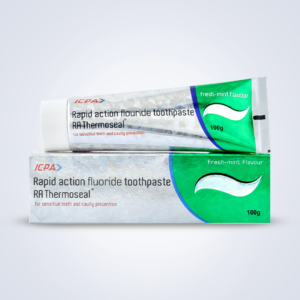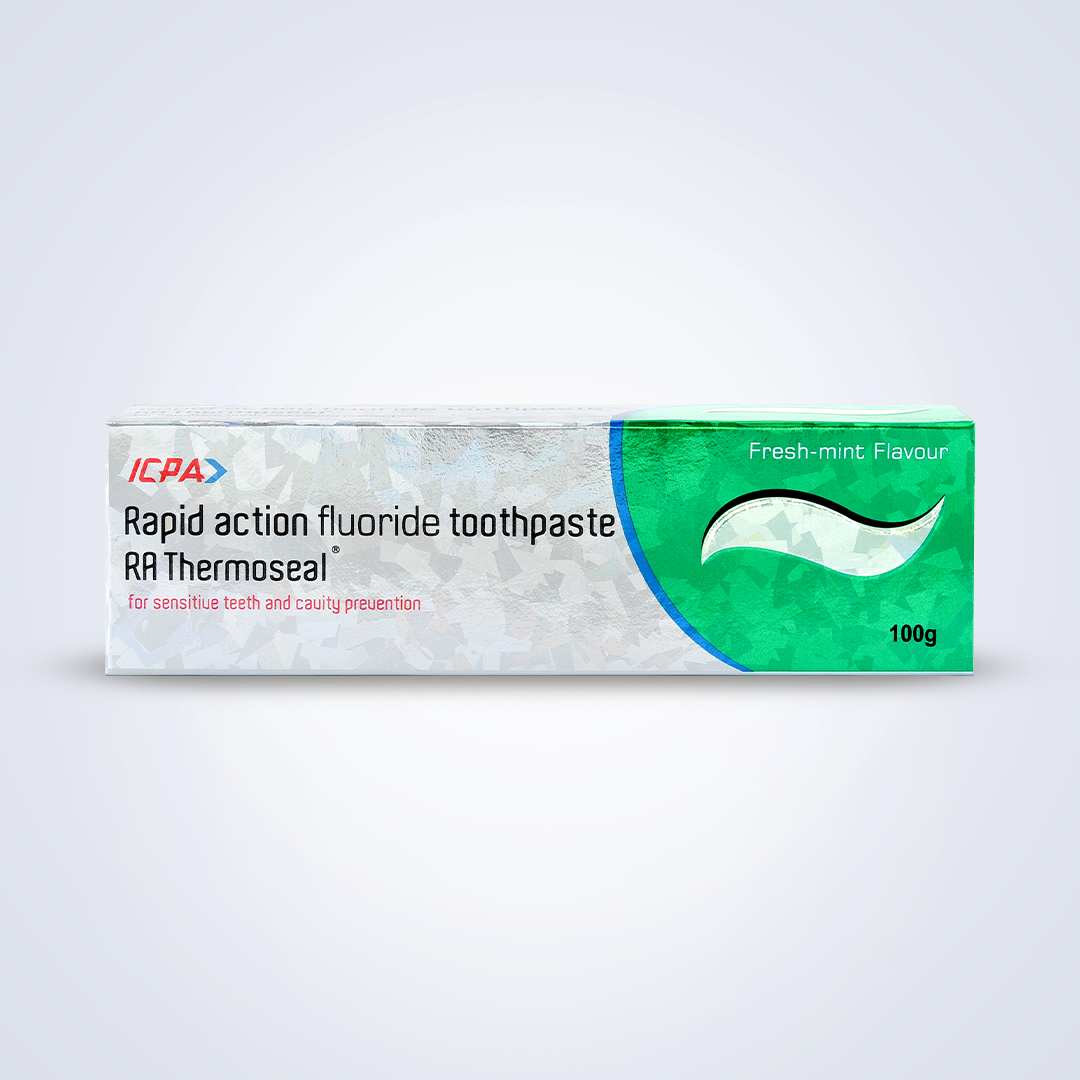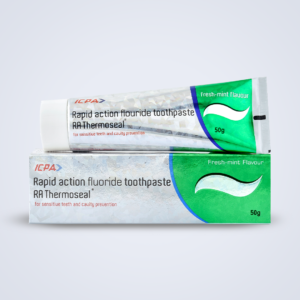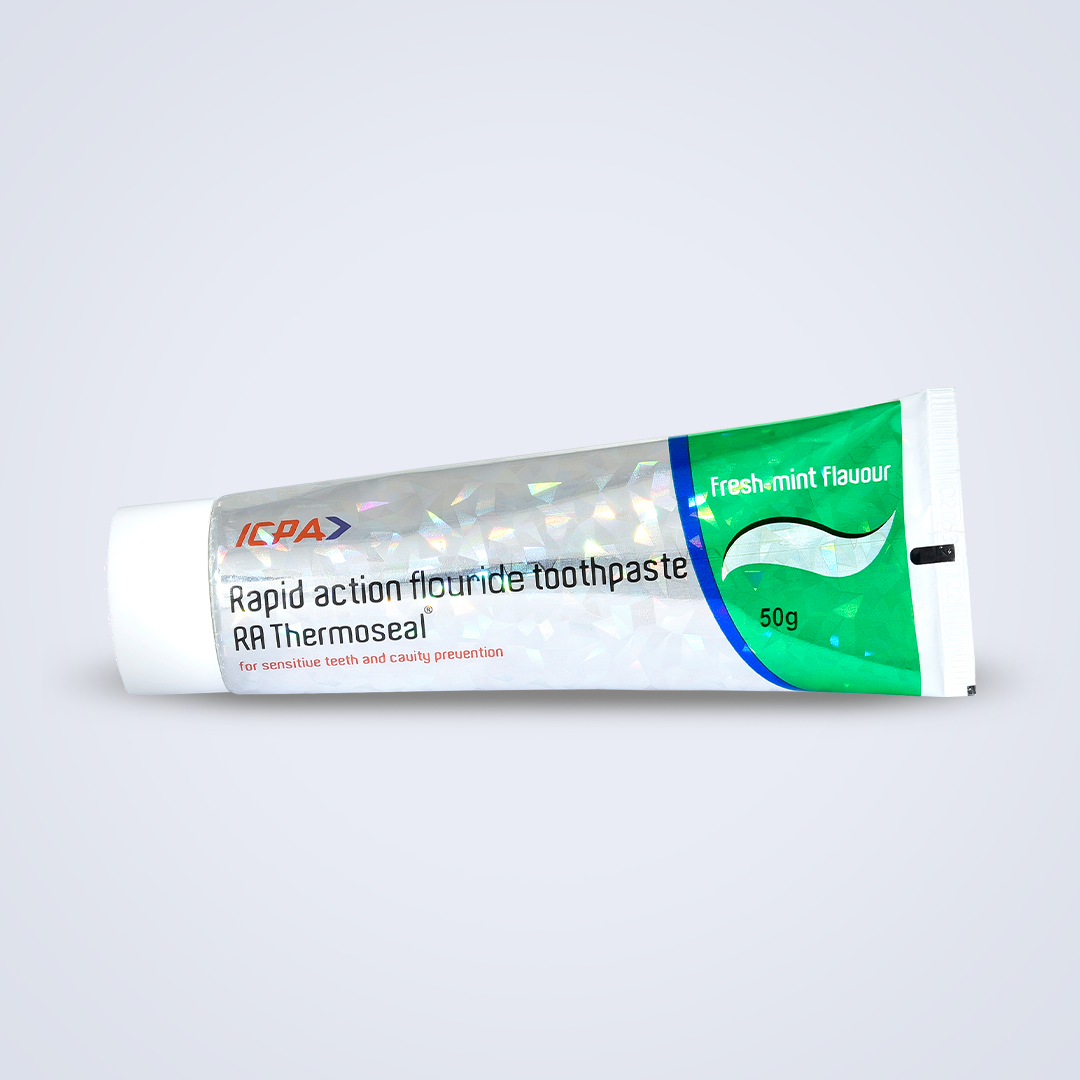Dental hypersensitivity
Dental hypersensitivity
Showing all 2 results
-
RA Thermoseal 100gm
Read More Quick ViewToothpaste for Dental Hypersensitivity
Composition:
Potassium Nitrate 5% w/w in toothpaste/gel base. Sodium monofluorophosphate 0.7% w/w (available fluoride content 917 ppm when packed).Mode of Action:
Dentinal hypersensitivity is a sharp pain produced in the teeth-, in response to stimuli, such as cold, heat, sweet, sour, or contact. It affects the quality of life and results in extreme discomfort or inability to eat or drink certain foods. It is caused due to opening of the dentinal tubules, after the enamel has been removed by factors such as attrition, abrasion, erosion, or gum recession. RA Thermoseal provides relief from dentinal pain by forming a neurosensory block. Fluoride provides cavity protection. It reduces the demineralization of enamel and dentin by decreasing the acid production of bacterial plaque and decreases the solubility of apatite crystals. It readily becomes incorporated as fluoroapatite layer, to reduce the dissolution of apatite during acid attacks.Indication:
Dentinal hypersensitivity.Directions:
Adults and children over 12 years of age should apply at least 2.5 cm (1”) strip of the product to a soft bristle toothbrush. Brush teeth to clean all surfaces thoroughly with RA Thermoseal toothpaste/gel at least twice a day (morning and evening), or as recommended by a dentist or doctor. Make sure to brush sensitive areas for a longer time.Uses:
- Builds increasing protection against sensitivity of teeth to cold, heat, acids, sweets or contact.
- Helps in the prevention of dental cavities.
Warnings:
For usage beyond 4 weeks, please consult a dentist or doctor. Keep out of reach of children under 6 years of age. Stop use and ask a dentist if the problem persists or worsens.Presentation:
Lamitube of 50g (1.76 oz) / 100g (3.52 oz), Gel in lamitube of 100g (3.52 oz). -
RA Thermoseal 50gm
Read More Quick ViewComposition:
Potassium Nitrate 5% w/w in toothpaste/gel base. Sodium monofluorophosphate 0.7% w/w (available fluoride content 917 ppm when packed).
Understanding the tooth structure:
For an effective management of dentinal hyprsensitivity, it is essential to understand the tooth structure and the roles of enamel, dentin, and pulp, as well as how they contribute to or are affected by tooth sensitivity.
1. Enamel:
a. Enamel is the outermost layer of the tooth, and it is the hardest and most mineralized tissue in the human body.
b. Enamel serves as a protective shield for the more sensitive inner layers of the tooth, primarily dentin and pulp.
c. It is a non-living tissue and is devoid of nerve endings, which means it does not transmit pain or sensations.2. Dentin:
a. Dentin is located beneath the enamel and makes up the bulk of the tooth structure.
b. It is a living tissue, containing microscopic tubules that extend from the outer surface of the dentin (adjacent to the enamel or cementum) to the pulp chamber in the center of the tooth.
c. These dentinal tubules house nerve endings and fluid-filled channels, connecting to the dental pulp.
d. Dentin is responsible for transmitting sensations or pain to the pulp when it is stimulated by external factors.3. Pulp:
a. The pulp is the innermost portion of the tooth, residing in the pulp chamber and extending into the root canals.
b. It contains vital components like blood vessels, nerves, and connective tissues.
c. The pulp is responsible for nourishing and maintaining the tooth, as well as detecting and responding to external stimuli.
d. When dentin is exposed or irritated due to factors like enamel erosion, gum recession, or tooth decay, the pulp may transmit pain signals, causing tooth sensitivity.In relation to tooth hypersensitivity:
- Enamel erosion or loss can expose the underlying dentin to external stimuli, which can lead to hypersensitivity. Enamel acts as a protective barrier, and when it is compromised, it can no longer shield the dentin from temperature changes, acidic foods, or pressure.
- Dentin, with its tubules and nerve endings, is the primary culprit in tooth sensitivity. When the dentinal tubules are open or exposed, they can transmit sensations and pain to the pulp, causing discomfort or sharp pain.
- The pulp is the nerve center of the tooth, and it plays a crucial role in sensing and responding to external stimuli. When it receives signals from the dentin due to hypersensitivity, it may trigger pain responses, leading to the discomfort associated with sensitive teeth.
In summary, enamel protects the inner tooth structures, dentin contains the nerve endings responsible for tooth sensitivity, and the pulp is the central nervous system of the tooth that responds to external stimuli. Understanding the roles of these tooth structures is important in managing and addressing hypersensitivity.
Dentinal hypersensitivity (Sensitive teeth)
Dentinal hypersensitivity, also known as tooth sensitivity or sensitive teeth, is a common dental condition where an individual experiences short sharp pain arising from exposed dentin in response to stimuli, typically thermal, evaporative, tactile, osmotic, or chemical, and which cannot be ascribed to any other form of dental defect or pathology. This discomfort typically originates from the dentin, which is the inner layer of the tooth, lying beneath the protective enamel and cementum.
Common triggers:
Dentin contains tiny tubules that connect to the nerve endings in the dental pulp, and when these tubules are exposed or stimulated, it can lead to tooth sensitivity. Common triggers for dentinal hypersensitivity include:
1. Hot or cold foods and beverages.
2. Sweet or sour foods.
3. Cold air or cold water exposure.
4. Brushing or flossing teeth.
5. Pressure from biting or chewing.Etiology:
There are several potential causes of dentinal hypersensitivity, including:
1. Tooth enamel erosion: Enamel is the outermost layer of the tooth, and if it wears away due to factors like acid erosion from acidic foods or beverages, tooth grinding (bruxism), or aggressive toothbrushing, it can expose the dentin.
2. Gum recession: When the gum tissue recedes, it exposes the tooth roots, which are not protected by enamel. The dentin on these exposed areas is more susceptible to sensitivity.
3. Tooth decay or cavities: If cavities form and progress to the dentin, it can cause sensitivity.
4. Cracked or chipped teeth: These can create pathways for stimuli to reach the dentin, causing sensitivity.Management of dentinal hypersensitivity:
To manage dentinal hypersensitivity, individuals can try various approaches, including:
1. Using desensitizing toothpaste: Special toothpaste formulations contain compounds like potassium nitrate or fluoride that can help block the tubules in the dentin, reducing sensitivity.
2. Avoiding acidic and abrasive foods: Minimizing consumption of acidic foods and drinks and using a soft-bristle toothbrush can help prevent further enamel erosion.
3. Good oral hygiene: Maintaining regular oral hygiene practices, such as proper brushing and flossing, can prevent the development of cavities and gum disease.
4. Dental treatments: In some cases, a dentist may recommend treatments like fluoride varnishes, bonding, or dental sealants to address sensitivity.It’s essential to consult a dentist if you experience persistent or severe dentinal hypersensitivity to determine the underlying cause and receive appropriate treatment. Your dentist can provide guidance on managing and addressing your specific condition.
Mode of Action:
RA Thermoseal provides relief from dentinal pain by forming a neurosensory block. Fluoride ensures tooth surface remineralization. It reduces the demineralization of enamel and dentin by decreasing the acid production of bacterial plaque and decreases the solubility of apatite crystals. It readily becomes incorporated as fluoroapatite layer, to reduce the dissolution of apatite during acid attacks.
Potassium Nitrate and Sodium Monofluorophosphate based toothpastes are recommended by the standard textbooks as the first line treatment for dentinal hypersensitivity.
Indications:
1. Patients complaining of sensitive teeth. (Dentinal hypersensitivity).
2. Post-scaling sensitivity.
3. In tooth whitening treatments. Patients can start RA Thermoseal 2 weeks before the tooth whitening appointment.Directions:
Adults and children over 12 years of age should apply at least 2.5 cm (1”) strip of the product to a soft or ultrasoft bristle toothbrush. Brush teeth to clean all surfaces thoroughly with RA Thermoseal toothpaste/gel at least twice a day (morning and evening), or as recommended by a dentist or doctor. Make sure to brush sensitive areas for a longer time.
Uses:
1. Builds increasing protection against sensitivity of teeth to cold, heat, acids, sweets or contact.
2. Helps in the prevention of dental cavities.Warnings:
For usage beyond 4 weeks, please consult a dentist or doctor. Keep out of reach of children under 6 years of age. Stop use and ask a dentist if the problem persists or worsens.
Presentation:
Lamitube of 50g (1.76 oz) / 100g (3.52 oz), Gel in lamitube of 100g (3.52 oz).
Quick Links
Our Products
Information
Contact us
- 216-219, Adarsh Industrial Estate, Sahar Road, Chakala, Andheri (East), Mumbai - 400099
- Fax : 28216928
- +91 22 40065305 / 40065306 / 40065307
- info@icpahealth.com


Selected Icpa Products
Click on Add to cart to add this item in cart.
| PRODUCTS | QTY | PRICE | VALUE in INR |
|---|
Selected Icpa Products
Click on Add to cart to add this item in cart.
| PRODUCTS | QTY | PRICE | VALUE in INR |
|---|




